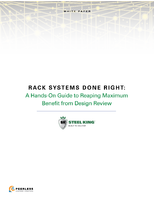Software makes air bending a standardized production technology.
Share:
Press Release Summary:
Programmable Dynamic Thickness Compensation(TM) (DTC) uses on-the-fly compensation to overcome material variations. It allows air bending to be used to achieve precision, repeatable bend angles. DTC software calculates material thickness with microsecond calculation capability before each bend and automatically determines ram reversal position needed to deliver precise bend angle in 1 ram stroke. Ram speeds of 30 ipm or higher are possible.
Original Press Release:
"On the fly" bend compensation adjusts for thickness variations to optimize speed, flexibility and economies of air bending
Dynamic Thickness Compensation, integrated into PC control, lets Autoform press brakes deliver precise air bend angles without additional equipment, cost or production time
August 2002 - Cincinnati Incorporated optimizes the speed, economies and flexibility of air bending by using exclusive on-the-fly compensation technology to overcome the effects from material variations. Developed by Cincinnati's research lab, Dynamic Thickness Compensation(TM) (DTC) makes air bending a standardized production technology for achieving precision, repeatable bend angles without add-on equipment, extra steps or extra expense. Standard on Cincinnati Incorporated's PC-controlled Autoform press brakes, DTC addresses the inherent problem of thickness variation in air bending, which can yield inaccurate bend angles. DTC software calculates material thickness before each bend and automatically determines ram reversal position needed to deliver a precise bend angle in one ram stroke at production speed. There is no stopping of the ram during on-the-fly calculations and ram speeds of 30ipm or higher are possible.
The innovative thickness compensation eliminates out-of-spec angles caused by inconsistent sheet gage thickness, which can increase scrap and rework or require production slowdowns for manual thickness checks. DTC also maintains feature parallelism and overall part dimensions by eliminating error stack-up on multiple-bend parts.
DTC is especially helpful for shops that can't afford premium sheet or material that has undergone highly accurate measurement before shipping. It eliminates the need for in-house sheet and coil sorting of same-gage material, which can vary by ±0.005" or more in thickness, and allows processing of mixed batches from different suppliers.
Automatic thickness compensation with no slowdown
DTC unites the precision action of Cincinnati press design with the programmability and microsecond calculation capability of PC control. The operator uses the Autoform's PC control panel to select the tool dimension files and enter nominal material thickness for each press brake job. The press control then knows when to expect contact with the top of the sheet and senses any deviation from the nominal.
When the ram touches the top of the material, strain gages located on the back of the press detect the building load (standard on every Autoform press, strain gages are used to monitor press flex to avoid overload conditions, as well as for DTC). DTC software collects the load readings from the strain gages until just before the material reaches its yield point. The software then performs a least squares calculation to determine material thickness from the near-linear strain gage data. The calculated thickness is compared to the nominal thickness entered into the control at the beginning of the job, and a new ram reversal position is immediately determined based on the difference between the two values. The ram then continues through to finish the bend in one stroke with no slowing of the ram during thickness calculation.
The DTC feature is a more cost- and production-effective compensation method than add-on probe or sensors which detect and adjust for material variations.
Probing procedures require two ram strokes, as well as a laser or mechanical probe that is mounted on the press bed to measure the angle that is bent. The ram partially bends the material on the first stroke, then reverses to measure the angle. After the initial angle measurement, a second stroke completes the bend. This method is more time consuming and more expensive, due to the additional ram stroke and auxiliary probing equipment which is prone to damage.
A different compensation method, using angle sensors embedded within a specialized upper tool to measure bend angle, also drives up cost because it requires more expensive tooling and a special sensor-to-control interface. It, too, extends production time because two ram strokes are needed to complete the bend.
For more information on Dynamic Thickness Capability and Autoform CNC Press Brakes, contact Cincinnati Incorporated, Box 11111, Cincinnati OH 45211. Phone (513) 367-7100; fax (513) 367-7552, Email info@e-ci.com or visit the web site www.e-ci.com.




